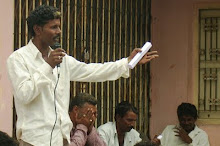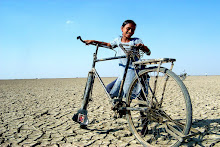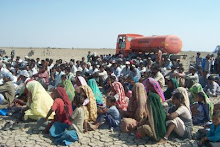Indian Express: Rajkot: Thursday, 8 Feb 2024.
On the floor of the Assembly, the state government conceded on Tuesday that some Narmada water does make its way to the Little Rann of Kutch and that it will take appropriate action.
Agariyas (salt pan workers)
cultivating salt in the Little Rann of Kutch bordering Halvad in Morbi district
have alleged that Narmada water flowing from canals of Sardar Sarovar Narmada
Nigam Limited (SSNNL) is flooding their salt pans, threatening to destroy salt
that will soon be ready for harvest.
On the floor of the Assembly, the state government conceded on Tuesday that some Narmada water does make its way to the Little Rann of Kutch and that it will take appropriate action.
In a written reply to a question asked by Congress MLA Dinesh Thakor, Minister of State for Salt Industries, Jagdish Panchal, said: “Water is not directly flowed to from Narmada canal to Little Rann of Kutch. But in emergency, escapes of canal are operated and water is discharged in streams, rivulets and rivers. Some of these streams, rivulets and rivers tail into the Little Rann of Kutch hence, water some time does end up in Little Rann of Kutch.”
Volume of such water is low as compared to those of other rivers, he added.
Thakor went on to ask if it was true that as of December 31, 2023, salt cultivated by agariyas was being washed away by fresh water being released from canals of Narmada dam project. In reply to his another question on what the government has done in the last two years to prevent loss of salt this way, Panchal said the state government will “in accordance of law, take appropriate action”.
Agariyas said their salt pans abutting Ajitgadh, Mangadh, Tikar, Jogad and Kidi villages, among others, have been flooded by Narmada water streaming down from SSNNL’s Maliya branch canal to Little Rann of Kutch through local rivers and rivulets. Suresh Raghavji, an Agariya from Tikar, said that Narmada water started flooding Little Rann of Kutch around a month ago. “The damage is on a very large scale,” he added.
Manhar Devji from Tikar said that Narmada water threatens to destroy salt cultivated in around 500 salt pans each in Little Rann of Kutch tracts bordering villages like Tikar, Ajitgadh, Mangadh, Jogad and Kidi, which will soon be ready for harvest. “Water is submerging our patas, each having 50 to 60 tonne of salt,” he said, requesting the government to stop flow of Narmada water at the earliest. “Otherwise, this water will submerge average 500 salt pans in these villages,” Manhar told mediapersons.
While managing director of SSNNL, Mukesh Puri, could not be reached for comments, sources in SSNNL said that Narmada water, being channelled to Saurashtra and north Gujarat for irrigation purpose, making its way to Little Rann of Kutch has been an issue for the past three to four years.
“But it is not that SSNNL discharges Narmada water into Little Rann of Kutch on purpose. We are neither discharging additional water nor wasting the precious water that is pumped to our canals by consuming lots of electricity. The main reason is return flow, the surface and sub-surface excess water that drains from farmers field after irrigating crops through flooding method,” said a senior SSNNL functionary.
Maliya branch canal, which offtakes from Saurashtra branch canal of SSNNL in Surendranagar, runs parallel to the eastern border of Little Rann of Kutch and tails in Malia taluka of Morbi after passing through Lakhtdar, Dasada and Dhrangadhra in Surendranagar and Halvad and Malia in Morbi.
“This problem is not limited to Morbi only. Around four lakh hectare of Narmada dam’s command area falls on the border of Little Rann of Kutch and SSNNL is duty-bound to provide farmers of these areas irrigation water when they demand it. However, many a time, farmers operate canal gates on their own and that exacerbates water flowing to Little Rann of Kutch,” the official said. Instead of the more common method of flooding salt pans with seawater, agariyas cultivating salt in Little Rann of Kutch fill their pans with salty groundwater by pumping it out with oil engines and motor pumps. The cultivation season starts in October-November and harvest begins in April.
Sources said that flow in Maliya branch canal has already decreased by around two-third. “From the peak of around 1,000 cusec (cubic feet per second) in November-December, the discharge has decreased now to average 300-350 cusec. This means less water will be flowing to farmers’ fields,” said a source.
Harinesh Pandya, president of NGO Agariya Hit Rakshak Manch said the state will have to find a long-term solution. “Narmada dam project is worth Rs 90,000 crore and still, so much water is going waste in Surendranagar and Morbi even as farmers of Kutch are waiting for their share. This waste has to stop, not to protect the livelihood of agariyas and farmers but to also prevent damage that freshwater can do to desert ecology,” he added.
Pandya said Narmada water has flooded an Little Rann of Kutch tract around 40 km long and seven km across Surendranagar and Morbi. “There is similar flooding at Santalpur in Patan and Rapar in Kutch but there have been no complaints, as the forest department has prevented agariyas from cultivating salt in those areas this year.”
On the floor of the Assembly, the state government conceded on Tuesday that some Narmada water does make its way to the Little Rann of Kutch and that it will take appropriate action.
 |
| Agariyas try to contain flow of Narmada water in Little Rann of Kutchnear Tikar in Halvad. (Express Photo) |
On the floor of the Assembly, the state government conceded on Tuesday that some Narmada water does make its way to the Little Rann of Kutch and that it will take appropriate action.
In a written reply to a question asked by Congress MLA Dinesh Thakor, Minister of State for Salt Industries, Jagdish Panchal, said: “Water is not directly flowed to from Narmada canal to Little Rann of Kutch. But in emergency, escapes of canal are operated and water is discharged in streams, rivulets and rivers. Some of these streams, rivulets and rivers tail into the Little Rann of Kutch hence, water some time does end up in Little Rann of Kutch.”
Volume of such water is low as compared to those of other rivers, he added.
Thakor went on to ask if it was true that as of December 31, 2023, salt cultivated by agariyas was being washed away by fresh water being released from canals of Narmada dam project. In reply to his another question on what the government has done in the last two years to prevent loss of salt this way, Panchal said the state government will “in accordance of law, take appropriate action”.
Agariyas said their salt pans abutting Ajitgadh, Mangadh, Tikar, Jogad and Kidi villages, among others, have been flooded by Narmada water streaming down from SSNNL’s Maliya branch canal to Little Rann of Kutch through local rivers and rivulets. Suresh Raghavji, an Agariya from Tikar, said that Narmada water started flooding Little Rann of Kutch around a month ago. “The damage is on a very large scale,” he added.
Manhar Devji from Tikar said that Narmada water threatens to destroy salt cultivated in around 500 salt pans each in Little Rann of Kutch tracts bordering villages like Tikar, Ajitgadh, Mangadh, Jogad and Kidi, which will soon be ready for harvest. “Water is submerging our patas, each having 50 to 60 tonne of salt,” he said, requesting the government to stop flow of Narmada water at the earliest. “Otherwise, this water will submerge average 500 salt pans in these villages,” Manhar told mediapersons.
While managing director of SSNNL, Mukesh Puri, could not be reached for comments, sources in SSNNL said that Narmada water, being channelled to Saurashtra and north Gujarat for irrigation purpose, making its way to Little Rann of Kutch has been an issue for the past three to four years.
“But it is not that SSNNL discharges Narmada water into Little Rann of Kutch on purpose. We are neither discharging additional water nor wasting the precious water that is pumped to our canals by consuming lots of electricity. The main reason is return flow, the surface and sub-surface excess water that drains from farmers field after irrigating crops through flooding method,” said a senior SSNNL functionary.
Maliya branch canal, which offtakes from Saurashtra branch canal of SSNNL in Surendranagar, runs parallel to the eastern border of Little Rann of Kutch and tails in Malia taluka of Morbi after passing through Lakhtdar, Dasada and Dhrangadhra in Surendranagar and Halvad and Malia in Morbi.
“This problem is not limited to Morbi only. Around four lakh hectare of Narmada dam’s command area falls on the border of Little Rann of Kutch and SSNNL is duty-bound to provide farmers of these areas irrigation water when they demand it. However, many a time, farmers operate canal gates on their own and that exacerbates water flowing to Little Rann of Kutch,” the official said. Instead of the more common method of flooding salt pans with seawater, agariyas cultivating salt in Little Rann of Kutch fill their pans with salty groundwater by pumping it out with oil engines and motor pumps. The cultivation season starts in October-November and harvest begins in April.
Sources said that flow in Maliya branch canal has already decreased by around two-third. “From the peak of around 1,000 cusec (cubic feet per second) in November-December, the discharge has decreased now to average 300-350 cusec. This means less water will be flowing to farmers’ fields,” said a source.
Harinesh Pandya, president of NGO Agariya Hit Rakshak Manch said the state will have to find a long-term solution. “Narmada dam project is worth Rs 90,000 crore and still, so much water is going waste in Surendranagar and Morbi even as farmers of Kutch are waiting for their share. This waste has to stop, not to protect the livelihood of agariyas and farmers but to also prevent damage that freshwater can do to desert ecology,” he added.
Pandya said Narmada water has flooded an Little Rann of Kutch tract around 40 km long and seven km across Surendranagar and Morbi. “There is similar flooding at Santalpur in Patan and Rapar in Kutch but there have been no complaints, as the forest department has prevented agariyas from cultivating salt in those areas this year.”
















.jpg)
.jpg)
.jpg)
.jpg)













No comments:
Post a Comment